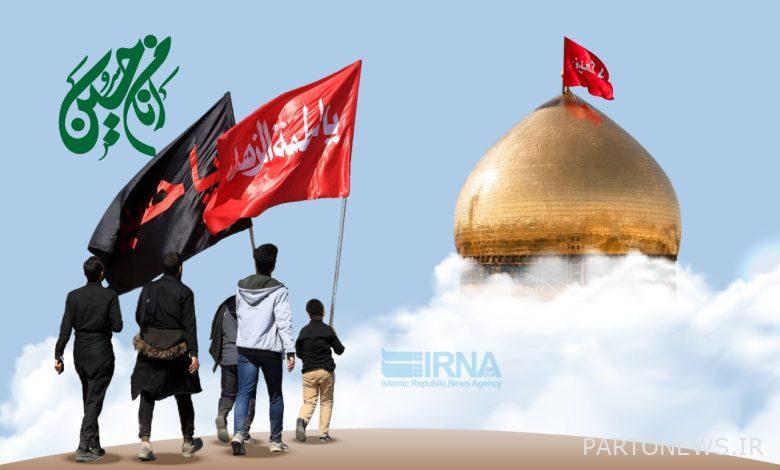The start of Arbaeen journeys from today/what pilgrims should know + film

According to IRNA, this year the governments of Iran and Iraq agreed to open the borders of the two countries for the pilgrims who wish to visit the blessed Beqaa of Iraq, especially Abu Abdullah al-Hussein (a.s.) and his companions. There was a delay, it was decided to start the process of sending Arbaeen pilgrims earlier so that there would be no problem in serving the pilgrims.
According to Interior Minister Ahmad Vahidi, five million pilgrims are expected to travel to Iraq for this year’s Arbaeen. Therefore, the volunteers were asked to register in the Samah system in order to predict more accurate numbers and estimates.
The Minister of Interior, who is responsible for coordination with the Iraqi side for the Arbaeen trip, emphasized: All predictions and efforts are for the Arbaeen trip to be a safe and good trip, and on this basis, negotiations with the Iraqi side have been conducted and they have assured that the security but the issue of safety and security are two issues and pilgrims should be insured so that if they have a problem in terms of safety, the insurance can compensate for the damage.
He announced that Iran has prepared its borders to send pilgrims and there will be no delay on this side of the border, he said: The Iraqi side has also been asked to consider the amount of entry from the gates of the country so that the pilgrims will not be delayed and they have promised that increase the number of entries, if this is achieved, we will not have permanency at the border; This means that pilgrims’ work will be done at the entrance of Iraq as much as it is done at the exit of Iran, so that they will not be delayed.
This year, Mehran, Khosravi, Shalamcheh, Chazaba border crossings, as well as 2 border crossings in the northwest, including Tamrchin in West Azarbaijan province and Bashmaq in Kurdistan province, have been considered to facilitate the border traffic of Arbaeen pilgrims, and traffic from Khosravi border from 16 Muharram (23 August) is possible.
Now, the services considered for Arbaeen pilgrims in the land borders of Iran are reviewed so that the compatriots can go on this spiritual journey with more knowledge:
Provision of transportation system for pilgrims
According to the plans, the fleet of public road transport is planned to send pilgrims to the border crossings, but as the Minister of the Interior has announced, we are facing a large volume of pilgrims this year, and we undoubtedly have shortages in the field of public transport; For this reason, it has been decided that pilgrims will have the possibility to use private cars, and therefore packings have been considered at the border.
However, regarding the fact that Iranians can enter Iraqi territory with a private car, the Minister of the Interior says: “There is no definitive word or agreement on this matter with the Iraqi side, and information will be provided if there is an agreement.”
Shahriar Efendizadeh, Deputy Minister of Transportation of the Ministry of Roads and Urban Development, has announced that eight thousand buses are expected to transport Arbaeen pilgrims, and according to estimates, 93% of Arbaeen pilgrims will travel by road.
Of course, due to the high volume of passengers, it is expected that another 6,000 buses will be needed to cover Arbaeen, and the Deputy Minister of Roads announced that they are seeking to provide them through the Arbaeen headquarters, ministries, organizations and the armed forces.
Also, due to Arbaeen trips from 16th to 30th of Shahrivar, it has been announced to the railway company not to have 100% advance sales during these days, so that if needed, other trains can be used for the Tehran-Ahvaz-Shalmeche route. Regarding bus tickets, the Ministry of Roads will have meetings with trade unions to coordinate the prices and how to sell them.
According to Efendizadeh, since the bus goes on one side of the route without passengers, the pricing method for its ticket is different.
He also emphasized: for the advance sale of tickets, especially for trains and airplanes during the Arbaeen days, arrangements will be made for the advance sale of tickets in person and online in September.
Accident insurance for pilgrims
Travel insurance is one of the facilities provided for pilgrims as in previous years. The Minister of Interior has announced that the amount received will be around 17-18 thousand tomans for each passenger.
It is important to mention that the amount received for the insurance premium is to compensate for possible and unwanted damage that may threaten pilgrims during any trip, including Arbaeen; Road accidents, the category of ensuring the security of pilgrims outside the border, as well as diseases and problems that may threaten a person’s health, are covered by this type of insurance.
It is necessary to carry a passport and a corona vaccine card
Having a valid passport that has not expired is required for any overseas trip, including the Arbaeen pilgrimage, so those who wish to visit the sacred shrines should renew or obtain a passport as soon as possible.
In the next step, considering that the corona virus has not been completely eradicated, it is mandatory to inject two doses of the corona vaccine, and the pilgrims must bring their vaccination card.
The national officials and the governors of the border towns have repeatedly emphasized: the people who come to the border without passports and vaccination cards, the Iraqi state will not allow them to enter under any circumstances.

The possibility of congestion at the borders
One thing officials always emphasize about traveling to holy shrines during Arbaeen is that volunteers should not delay their journey. Now, this recommendation for this year, when the number of pilgrims is expected to reach about 5 million people – that is, about three times the number of years before Corona – this recommendation is even more important so that the hosts can also provide good and worthy service to the guests of the Prophet. Aba Abdullah al-Hussein (a.s.) come.

How is the preparation of the borders for the presence of pilgrims/the state of the borders?
The preparation of land borders to host pilgrims has started months ago; From this day, the Minister of Interior visited the borders, on the eve of the beginning of sending compatriots to the borders, and emphasized on the preparation of infrastructure, especially the road infrastructure at the Chezabeh border until the first of September, the installation of new water tanks to supply water to the pilgrims, and the installation of car parking. .
In the following, we will review the state of the borders for receiving pilgrims:
Khosravi border in Kermanshah province:
The Khosravi border in the westernmost point of Iran, with the largest international land terminal in the Middle East, is the oldest, main and at the same time the smoothest route for the traffic of our country’s visitors to the shrines of Iraq. The short distance of this border point with the pilgrimage cities of Iraq has caused many pilgrims to choose this route over traffic.
The Khosravi border route from Tehran to Khosravi is four-lane and one of the best routes, and it is closer than other borders of our country to access the northern, central, western, northwestern, eastern, and northeastern provinces, and it can be a route for easy access to Zwari. May they want to go to Karbala as soon as possible.
Also, after entering Qasr Shirin city, Arbaeen pilgrims can use the 15-minute route to reach the Khosravi border. Khosravi border terminal is one of the best and most equipped terminals in the Middle East. from all over the country.
In Qasr Shirin, 14 accommodation units, including hotels and guesthouses of first to third grade with 322 rooms and 1,500 beds, have been built since the early 80s so that pilgrims can stay in this border area on their way to Iraq.
Construction of new passport control gates, construction of fiber optics, equipping entry and exit halls for pilgrims, creation of restrooms, creation of a light tower device, renovation of cameras inside the entry and exit halls and the terminal area, creation of a parking lot with a capacity of 50,000 cars at 10 points of Qasr Shirin and Marz Khosravi, the deployment of buses to transport pilgrims from Qasr Shirin to the border of Khosravi, the installation of a canopy at the zero point of the border and the creation of fog sprinklers due to the heat of the weather are all suitable measures for the welfare of pilgrims.

Chezabeh and Shalamcheh in Khuzestan province:
Khuzestan province, having 2 border terminals of Shalamcheh and Chazabah, annually hosts a large crowd of Ahl al-Bayt fans and pilgrims of Imam Hussain (a.s.) especially during the Arbaeen days. During Arbaeen 2018, a total of 1 million 671 thousand 822 Iranian and foreign pilgrims traveled from the Shalamcheh border and 657 thousand 93 people traveled from the Chadaba border, and it is expected that these numbers will increase significantly in this year’s Arbaeen.
On the eve of Hosseini’s Arbaeen (AS) and in order to prepare the roads leading to the border terminals of Shalamcheh and Chazaba, five road maintenance projects including staining and asphalt covering of 70 km on Ahvaz-Abadan, Ahvaz-Khorramshahr roads, Imam Jafar Sadiq (AS) roads ), Abdul Khan – Bostan, Mahshahr – Abadan and 2 projects on Ahvaz – Hamidiyeh – Sosangard road with a total credit amounting to 700 billion Rials are underway.
According to the General Director of Roads and Road Transport of Khuzestan, in addition to carrying out infrastructure measures and preparing the roads leading to the border crossings of the province for Arbaeen days, considering that a significant part of the pilgrims use private cars to go to the border. It is expected that 10,588 buses, minibuses and taxis will be needed to move the rest.

Mehran border in Ilam province:
Mehran border is another high-traffic crossing during the days of Abein. According to the Governor of Ilam, the preparation and safety of the Hamil-Shabab-Ilam-Mehran axis is the priority for preparation and safety due to the high traffic of passengers during these days.
The governor of Ilam stated in this regard: the route from Hamil to Ilam and Ilam to Mehran Pard is the most trafficked axis of Arbaeen in the province, and every year it creates a lot of traffic, and it is necessary to increase the presence of police forces in this route in addition to detection and calming. The volume of road accidents will also decrease.
Now, 74 kilometers of Ilam four-lane road to Mehran border is ready for use, and the remaining eight kilometers are still under construction, but will be used as an emergency during the peak days of Arbaeen.
Water supply to Mehran city, installation of 53 water coolers on the route of pilgrims and creation of necessary infrastructure in parking lots has been done.
According to the governor of Mehran, there is no problem for the processions and people to access water, electricity and gas, and the capacity of Mehran has been increased by a 32 megawatt power station with a credit of 55 billion tomans.
Enclosing the Arbaeen parking lot, video monitoring, building a mosque, building toilets, creating lines and creating water cooler equipment, and creating the capacity to deploy 6,000 buses at the Barkat terminal are among other measures taken to host pilgrims at the Mehran border.

Tamerchin border in West Azarbaijan province:
This year, for the first time, Tamrchin border in West Azerbaijan will host Arbaeen pilgrims. According to Mohammad Sadegh Motamedian, the governor of West Azerbaijan, executive bodies in the province have been activated quickly to provide the necessary infrastructure for easy traffic by the end of this week.
The Tamrchin route is one of the closest routes, especially to the city of Samarra, which can be a very suitable route for Arbaeen pilgrims during the hot days of the year. This year, the capacity of the Tamrchin border will be used for the limited presence of pilgrims from the northwest and even the north of the country in the Hosseini Arbaeen ceremony, and efforts are being made for the presence of foreign pilgrims from the Caucasus region in this year’s Arbaeen ceremony.

